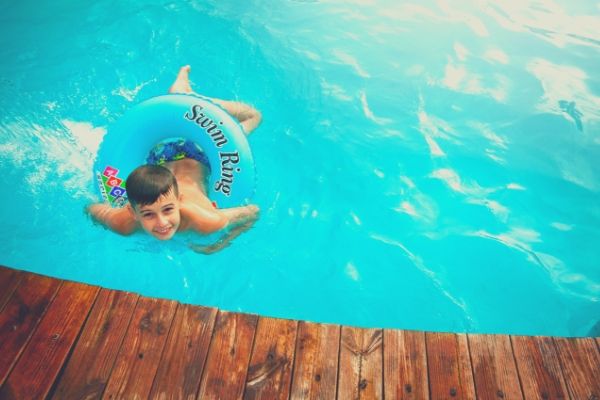In previous lessons, you learned how to set your child up for successful swimming lesson with you at home or with professionals at your local swim school. You learned the motto: “Have Fun! Build Confidence! Swim Safer!,” that our coaches use in our FUNdamentals beginner swimming lessons as a roadmap to success.Inside of that motto, we’ve taken a deeper dive into having fun in your lessons and how to help your child establish comfort in the water. In this lesson, we’ll take what you’ve learned a step further and teach you how to go about building your child’s confidence in beginner swimming skills and start the journey to safer swimming.
Learning to swim can be complicated for you and your child... or it can be simple
When teaching a child to swim, there are so many details that can pull you in and steal your focus. If you want to make things complicated, you can focus on the small details of head position, shoulder rotation, arm extension, tempo, hip rotation, kicking speed… et cetera. It’s almost limitless.
For beginner swimmers, we like to keep thing simple. We encourage coaches and parents who teach beginner swimmers the FUNdamentals to focus on the desired outcome and not so much on the minute details of the process. What that means is to focus on the desired results of comfort and forward propulsion.
If your goal for your child is safer swimming, let’s focus on that. If you have future plans for your child to join a swim team, that’s awesome - let’s get your child swimming safer first and then worry about tweaking their technique later.
We like to keep teaching beginner swimmers extremely simple and have boiled down the learn to swim process into 3 parts. 1) Comfort, 2) Propulsion and 3) Breath Control.
Kicking is FUNdamental to your child’s forward Propulsion
We already covered helping you get your child comfortable in the water. Now, we’ll focus on the propulsion skill set. For beginner swimmers, forward propulsion comes in 2 forms - kicking with the legs and pulling with the arms. This lesson is all about kicking!
It is not uncommon for kids to develop a successful front kick as a skill before they master paddle swimming. When kids play in the water, they often develop a powerful front kick that gets them from Point A to Point B in the pool, even as they leave their hands down at their sides.
A strong and properly performed front kick is one of the best safer-swimming tools in any young swimmer’s tool box! Good kicking technique allows children to propel themselves forward, reduces fatigue, and promotes safer swimming. It also helps kids have more fun while swimming, because they have more control over where they go and what they do in the pool.
Here’s how you can help your child develop a strong front kick similar to how coaches at our swim school do it.
All you need to get started is a pool noodle
Teaching your child to kick and develop basic forward propulsion is easier than you think!
- Start your child on the pool steps with water around chest height
- Set the noodle out in front of your child
- Your child’s chin should rest on the center of the noodle and his or her hands should hold the noodle on either side of the face at about shoulder width
- Stand in front of your child facing him or her and hold under the noodle, gently providing upward support to help keep your child’s chin out of the water
- As you leave the wall to start the exercise, move back slowly and verbally direct your child to kick their feet
As your child gets more comfortable with this skill you can let go of the noodle and create distance between the two of you before starting the exercise to allow your child to kick to you instead of with you. Practice this skill together 4-5 times a lesson and try to travel a distance of 10-20 feet.
Remember to keep simple goals for FUNdamental kicking
Your #1 goal is for your child to start generating forward propulsion on his or her own. Here are some other things to look for in a good beginner kick:
- Straight legs with relaxed knees and ankles - knees can bend slightly
- Controlled small, fast splashes
- Feet staying in the water - they can break the surface a bit, but should be mostly underwater
Get ready to Paddle Swim!
Our next lesson is about Paddle Swimming! If you want a reminder of when the post goes live, as well as updates on the rest of this series, sign up for our email announcements! You can also check out our lessons page, where we go over the skills your child will learn in our classes. For a child between the ages of 2.5 and 8 years old, we recommend the FUNdamentals course!





